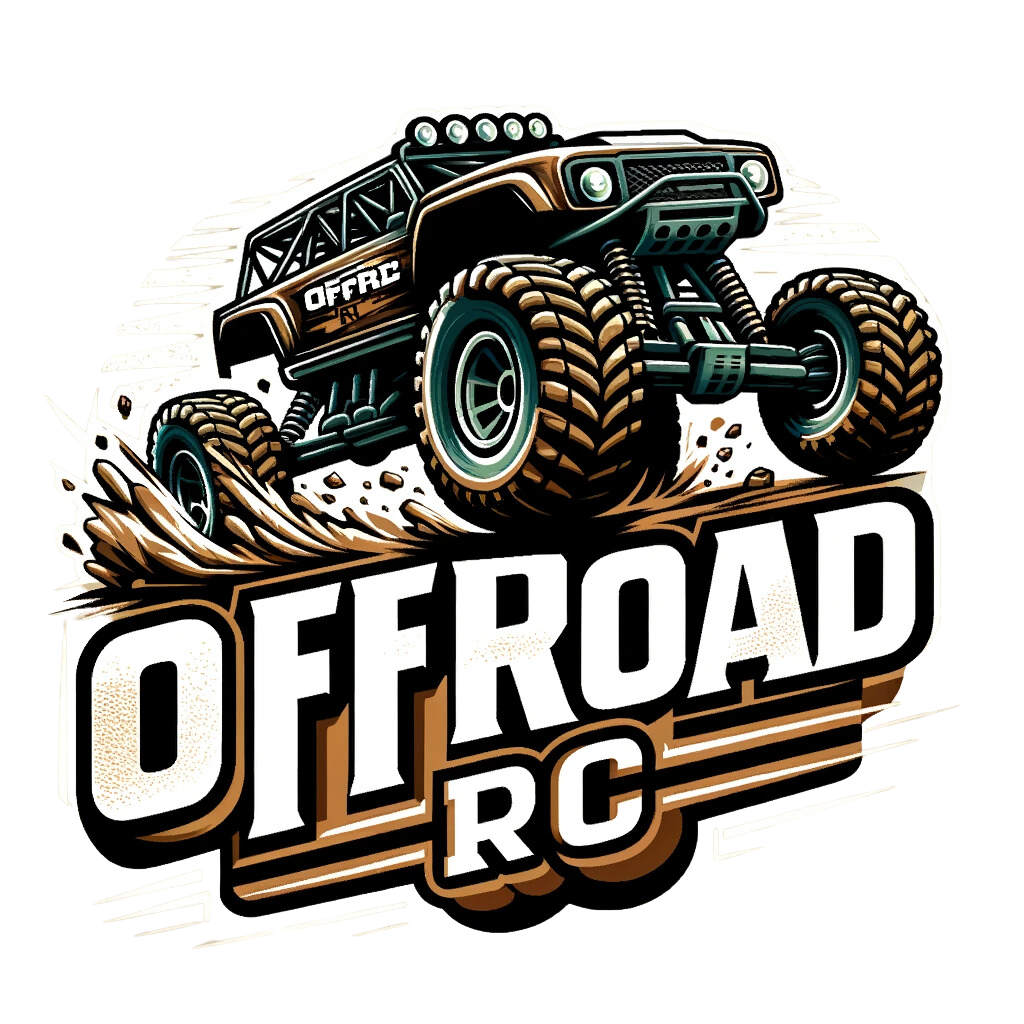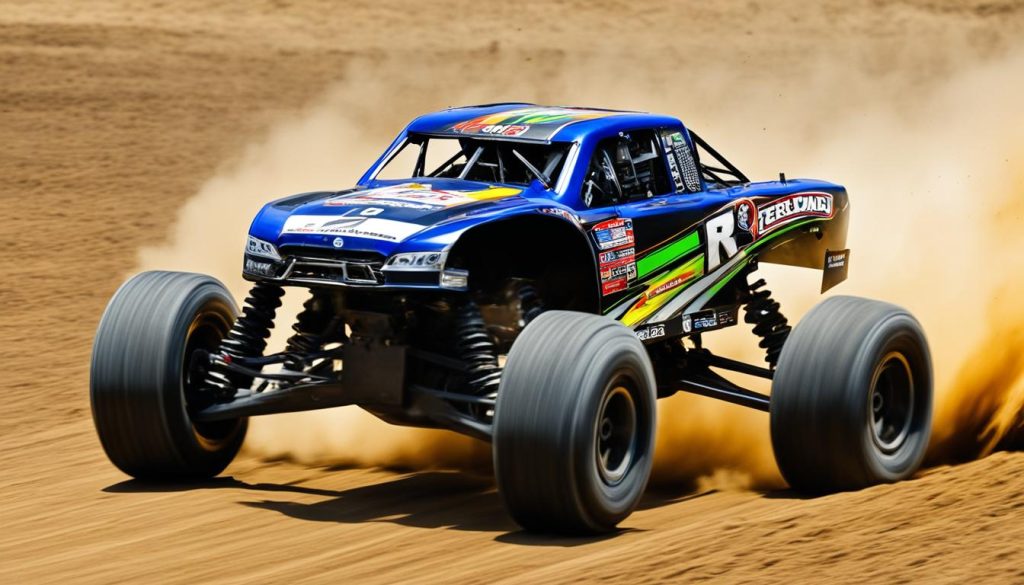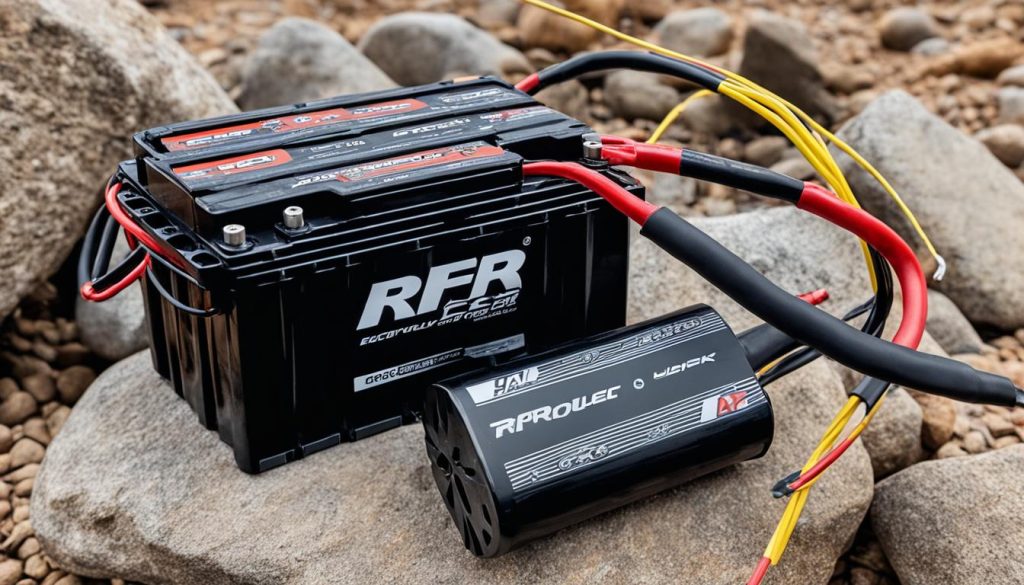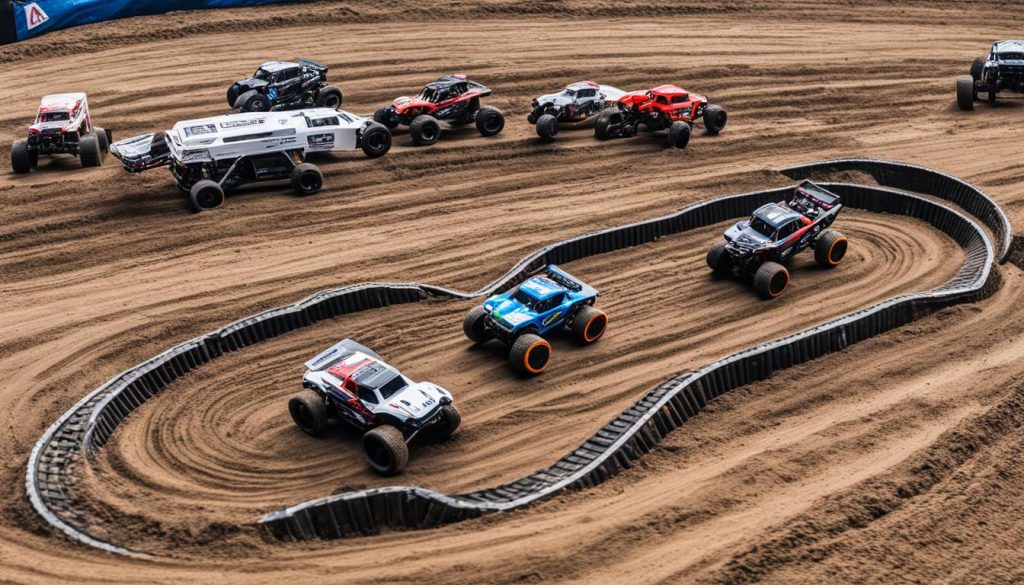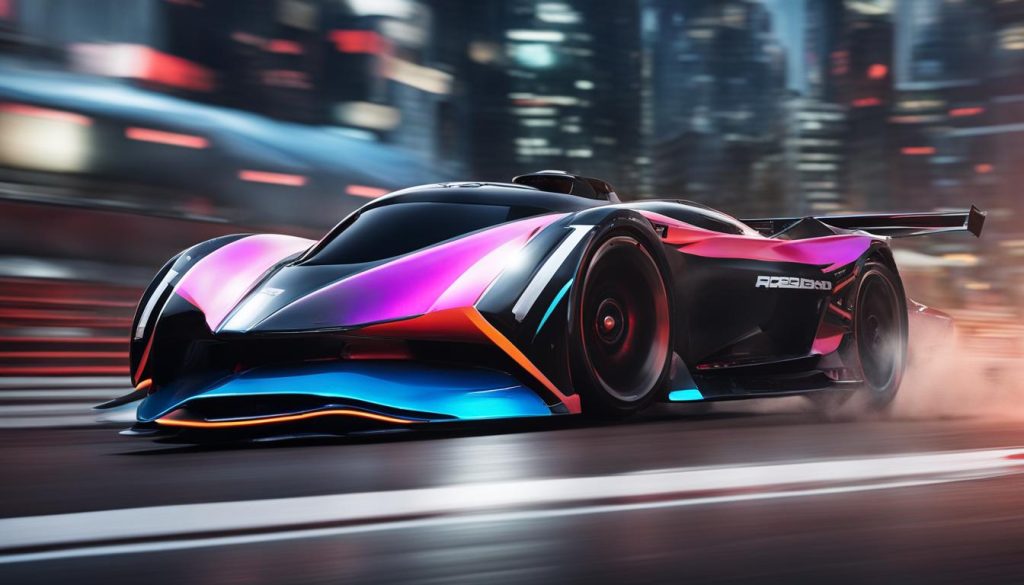Radio-controlled (RC) cars offer a thrilling world of speed and performance customization for enthusiasts like you. If you want to make your RC car go faster and have more power, it’s time to focus on boosting its torque. By understanding gear ratios and making targeted adjustments, you can enhance your RC car’s torque and take your racing experience to the next level.
Key Takeaways:
- Understanding gear ratios is crucial for optimizing torque in your RC car.
- You can increase torque by adjusting the gear ratio to a lower setting.
- Factors like surface conditions, motor and battery types, and environmental factors affect the optimal gear ratio for torque.
- Experimentation and regular testing are essential for finding the right gear ratio balance.
- For brushless RC cars, fine-tuning ESC settings can further optimize torque and overall performance.
Understanding Basic Concepts
RC cars are miniature model cars or trucks that can be operated remotely using a radio-frequency transmitter. They are powered by batteries or nitro engines and equipped with gears to control power and speed. Gear ratios represent the relationship between two gears, typically the pinion gear attached to the motor and the spur gear attached to the wheels. Understanding these basic concepts is essential for comprehending the impact of gear ratios on RC car performance.
| RC Car Components | Explanation |
|---|---|
| Radio-Frequency Transmitter | A handheld device that wirelessly controls the RC car by sending signals to the receiver. |
| Batteries or Nitro Engines | Power sources that provide energy to run the RC car. Batteries are commonly used in electric RC cars, while nitro engines use a mixture of fuel and air for combustion. |
| Gears | Mechanical components that transfer power from the motor to the wheels. Pinion gear is connected to the motor, and the spur gear is connected to the wheels. |
By understanding these basic concepts, you can gain insights into how RC cars function and how gear ratios play a crucial role in determining the performance of your RC car.
“Understanding the components and mechanics of an RC car is the foundation for optimizing its performance.”
The Role of Gear Ratios in RC Cars
Gear ratios play a vital role in determining the performance of your RC car. By adjusting these ratios, you can optimize power, speed, efficiency, and overall performance. Let’s explore how gear ratios impact the key aspects of your RC car’s performance.
Power Adjustment
One of the primary functions of gear ratios is power adjustment. A higher gear ratio increases the speed of your RC car, allowing it to zip across the track. However, this comes at the expense of torque. On the other hand, a lower gear ratio provides more torque, enabling your car to tackle off-road terrains and inclines with ease.
Speed Adjustment
If you prioritize speed over torque, adjusting the gear ratio to a higher value is the way to go. Higher gear ratios allow your RC car to reach faster speeds on straight sections of the track. Conversely, if you need greater control and acceleration for sharp turns or tracks with obstacles, opting for a lower gear ratio will give you the necessary speed adjustment.
Efficiency and Performance
Finding the right balance between speed and torque is crucial for achieving optimal efficiency and performance in your RC car. A gear ratio that strikes the perfect equilibrium ensures that your car performs well in different environments and tasks. Whether you’re racing on a smooth track or navigating through rough terrains, the right gear ratio helps you maintain control and maximize performance.
To better understand the impact of gear ratios on performance, let’s take a closer look at a comparison table:
| Gear Ratio | Speed | Torque | Efficiency |
|---|---|---|---|
| High Gear Ratio | Increased | Reduced | Higher efficiency on straight tracks |
| Low Gear Ratio | Decreased | Increased | Higher efficiency in off-road terrains |
As you can see from the table above, adjusting gear ratios allows you to fine-tune your RC car’s performance based on your specific needs. Whether you’re aiming for speed, torque, or a balance between the two, optimizing gear ratios is the key to unlocking the full potential of your RC car.
Key Factors Influencing Gear Ratios
When optimizing the gear ratio for your RC car, several key factors come into play. By considering these factors, you can select the best gear ratio for specific situations, ensuring optimal performance. Let’s explore these factors:
Surface and Track Conditions
The surface and track conditions have a significant impact on the ideal gear ratio for your RC car. On smooth, paved surfaces, a higher gear ratio is preferred as it enhances speed. However, for rough or off-road terrains, a lower gear ratio is necessary to provide sufficient torque for navigating challenging obstacles.
Motor and Battery Types
The type of motor and battery installed in your RC car also influences the gear ratio. Different motors and batteries have varying power outputs, affecting the overall performance of the car. It’s important to consider the specifications and capabilities of your motor and battery when determining the optimal gear ratio.
Environmental Factors
Environmental factors such as temperature and altitude can impact gear ratios due to their effect on motor performance. In colder temperatures, motors may experience decreased efficiency, requiring adjustments to the gear ratio for optimal performance. Similarly, at higher altitudes, air density changes can affect motor performance and necessitate gear ratio modifications. Take these environmental factors into account when fine-tuning your gear ratio.
By considering the surface and track conditions, motor and battery types, and environmental factors, you can determine the best gear ratio for your RC car. This will ensure that your car performs optimally in various scenarios, whether it’s racing on a smooth track or conquering off-road obstacles.
Tips to Optimize Gear Ratios in Your RC Car
Optimizing gear ratios is a key strategy to enhance the performance of your RC car. Whether you’re a beginner or an advanced user, there are several tips and techniques you can employ to find the optimal gear ratio. Here’s a guide to help you get started.
Beginners’ Tips:
- Start with the manufacturer’s suggested gear ratios. These ratios are a good baseline for your specific RC car model.
- Make adjustments based on different surface conditions. A higher gear ratio may be suitable for smoother tracks, while a lower gear ratio can provide better traction on rough terrains.
- Consider your performance requirements. If you need more acceleration and torque, opt for a lower gear ratio. For higher top speeds, choose a higher gear ratio.
Advanced Techniques:
For experienced users looking to fine-tune their gear ratios, here are some advanced techniques:
Adjust the pinion gear and spur gear. The pinion gear, connected to the motor, and the spur gear, attached to the wheels, have a direct impact on the gear ratio. Increase the number of teeth on the pinion gear for more speed, or decrease the teeth for increased torque. Conversely, adjusting the spur gear can have the opposite effect on speed and torque.
Monitoring the temperature of key components is crucial for optimizing gear ratios. Higher temperatures indicate potential strain on the motor and battery, suggesting the need for gear ratio adjustments. Consider using temperature sensors or thermal paste to effectively monitor and manage heat levels.
In some cases, changing the motor and battery can further enhance your RC car’s performance. Motors with different configurations and battery setups offer varying power outputs, allowing you to select the ideal combination for your specific needs. Research and experiment with different motor and battery choices to find the perfect match for your RC car.
Testing and Adjustments:
Regular testing and adjustments are essential when trying to find the optimal gear ratio for your RC car. Take your car to different tracks or terrains and collect performance data. Analyze the results, making note of any improvements or areas that require further tweaking. Small adjustments to the gear ratio can have a significant impact on performance, so don’t be afraid to experiment until you find the sweet spot.
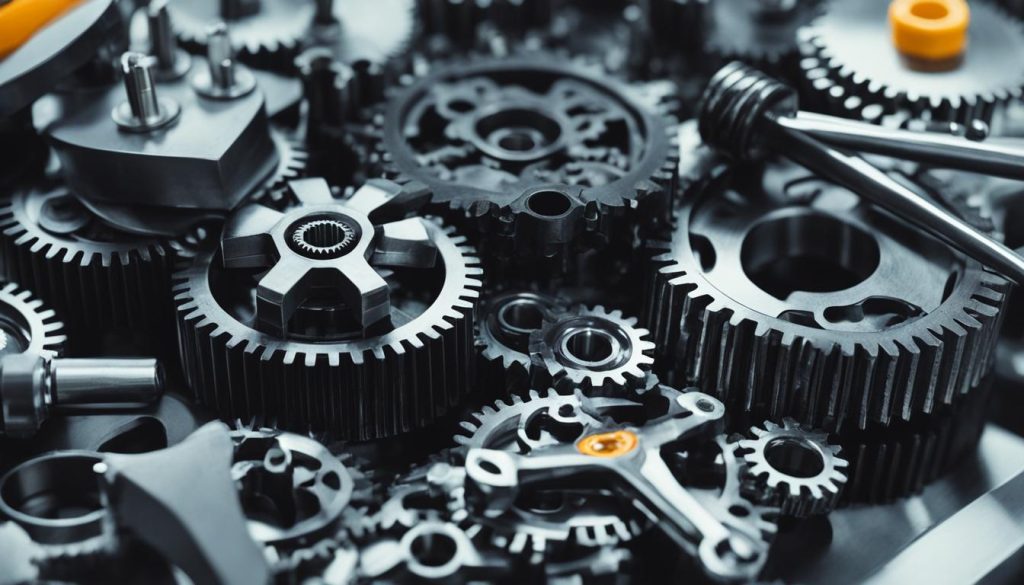
| Optimization Strategies | Beginners’ Tips | Advanced Techniques |
|---|---|---|
| Start with manufacturer’s suggested gear ratios | Adjust the pinion and spur gears | Monitor temperature levels |
| Make adjustments based on surface conditions | Monitor temperature levels | Consider motor and battery choices |
| Consider performance requirements |
Understanding Brushless RC Cars
Brushless motors are revolutionizing the world of RC cars, offering significant advantages over traditional brushed motors. These highly efficient motors are designed to deliver top-notch performance and exceptional durability. Whether you’re a beginner or an experienced RC car enthusiast, understanding the benefits of brushless motors and how to optimize their performance through motor tuning is key.
Benefits of Brushless Motors
- Longer Lifespan: Brushless motors are built to last, thanks to their durable construction and fewer moving parts. This translates to less wear and tear over time, allowing you to enjoy your RC car for longer.
- Higher Speeds: Brushless motors can deliver impressive speeds, making them ideal for those seeking exhilarating RC car racing experiences.
- More Power: These motors provide greater power output, giving your RC car the ability to tackle challenging terrains and conquer obstacles with ease.
- Less Maintenance: With brushless motors, you can enjoy more time driving and less time maintaining your RC car. Say goodbye to frequent motor brushed replacements and enjoy a hassle-free experience.
Now that you understand the benefits of brushless motors, it’s time to explore motor tuning to optimize their performance.
Motor Tuning for Brushless RC Cars
When it comes to motor tuning for brushless RC cars, the primary focus is on optimizing the gear ratios. This involves finding the right balance between torque and speed to suit your driving style and the RC car’s intended use.
To optimize the gear ratios, consider the following:
- Track Conditions: The surface and track layout play a crucial role in determining the ideal gear ratio. For tracks with long straight sections, a higher gear ratio can maximize speed. On the other hand, tracks with tight turns and off-road terrains may benefit from a lower gear ratio to enhance torque and maneuverability.
- Motor Selection: Choosing the right motor with the appropriate specifications, such as KV rating and power output, is essential for achieving the desired performance. Different motors may require specific gear ratios to operate optimally.
- ESC Programming: The Electronic Speed Control (ESC) plays a vital role in managing the power delivery from the motor to the wheels. Adjusting the ESC settings, such as throttle response and timing, can fine-tune the motor’s performance to complement the selected gear ratios.
By experimenting with different gear ratios, motor selections, and ESC settings, you can find the perfect combination that maximizes the potential of your brushless RC car.
| Track Type | Ideal Gear Ratio |
|---|---|
| Straight Track | Higher Gear Ratio |
| Off-Road or Tight Turns | Lower Gear Ratio |
Adjusting Gear Ratios for Brushless RC Cars
Gear ratio adjustments play a crucial role in customizing the performance of your brushless RC car for specific tracks and races. By modifying the gear ratio, you can optimize speed and torque according to the requirements of different racing conditions.
When it comes to achieving maximum speeds on straight sections of the track, a higher gear ratio is the way to go. This adjustment allows your brushless RC car to unleash its full potential in terms of speed, making it a formidable force on long, wide stretches where top speeds are crucial.
On the other hand, if you’re tackling off-road courses or tracks with tight turns, opting for a lower gear ratio is the ideal choice. Lower gear ratios emphasize torque, providing your brushless RC car with the power and stability needed to navigate challenging terrains and conquer hairpin bends with ease.
Finding the right balance between a higher gear ratio for speed and a lower gear ratio for torque is key to optimizing the performance of your brushless RC car. Experimentation and testing on different tracks will help you identify the gear ratio adjustments that suit your racing style and deliver the desired results.
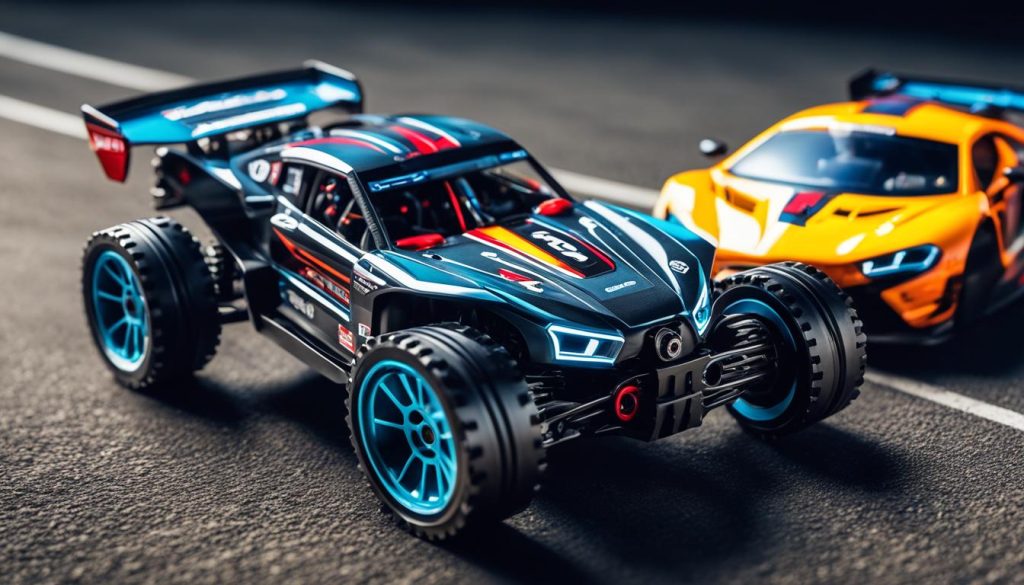
“By fine-tuning the gear ratio, you can unleash the true potential of your brushless RC car and dominate the competition on any track.”
Fine-Tuning ESC Settings for Brushless RC Cars
The ESC (Electronic Speed Control) is a crucial component of a brushless RC car. By fine-tuning the ESC settings, you can significantly impact the car’s acceleration, braking, and overall control, allowing for a customized and optimized racing experience.
One important aspect of ESC settings is adjusting the throttle punch. Throttle punch refers to the initial burst of power when you accelerate the car. By adjusting this setting, you can control the intensity of the acceleration, ensuring a smooth and controlled start. Experimenting with different throttle punch levels can help you find the right balance for your driving style and track conditions.
Another key setting to consider is the drag brake. The drag brake controls the amount of resistance or braking force that is automatically applied when you release the throttle. Increasing the drag brake setting provides more aggressive braking, which can be advantageous for tight turns and cornering. On the other hand, reducing the drag brake offers more coasting, allowing for smoother and more controlled turns. Adjusting the drag brake based on the track layout and race conditions can greatly improve your overall performance.
Modifying the maximum brake force is also important for optimizing your brushless RC car’s braking capabilities. Increasing the maximum brake force results in stronger braking, while decreasing it offers a more gradual and less abrupt stop. Finding the right balance that allows you to effectively control the car during braking is crucial for achieving faster lap times and maintaining stability on the track.
Motor timing is another setting that can have a significant impact on your car’s performance. Motor timing refers to the timing advance applied to the motor’s ignition sequence. By adjusting the motor timing, you can optimize the power delivery and efficiency of your brushless motor. However, it’s important to note that modifying motor timing should be done with caution, as excessive timing can overheat the motor and adversely affect its lifespan.
To summarize, fine-tuning ESC settings is a critical step in optimizing the performance of your brushless RC car. Adjusting the throttle punch, drag brake, maximum brake force, and motor timing settings allows for customization and optimization based on specific track requirements and individual driving preferences. By exploring and experimenting with these settings, you can unleash the full potential of your brushless RC car.
| ESC Settings | Description |
|---|---|
| Throttle Punch | Adjusts the initial burst of power during acceleration |
| Drag Brake | Controls the resistance or braking force when releasing the throttle |
| Maximum Brake Force | Determines the strength of the braking system |
| Motor Timing | Optimizes the power delivery and efficiency of the brushless motor |
Conclusion
Tuning your RC car for optimal torque is a combination of understanding gear ratios, making fine adjustments, and optimizing other components like the ESC. By finding the perfect balance between torque and speed, you can enhance the performance of your RC car and take your hobby to new heights.
Experimentation and testing are essential for achieving the ideal torque in your RC car. Start by familiarizing yourself with the basic concepts of gear ratios and their impact on performance. Then, explore different gear ratio options based on your desired outcome, whether it’s maximizing speed or increasing torque.
Don’t be afraid to make adjustments to your pinion and spur gears, monitor temperature levels, and consider upgrading your motor and battery. Regular testing and fine-tuning will help you find the optimum gear ratio for your RC car, ensuring it performs at its best in various environments and track conditions.
Remember, RC car tuning is a continuous process of improvement. Keep striving for performance enhancement by staying informed about the latest techniques and innovations in the world of RC car tuning. With dedication and passion, you can unlock the full potential of your RC car and enjoy the thrilling experience of high-performance driving.
FAQ
How can I increase the torque in my RC car?
To increase torque in your RC car, you can adjust the gear ratios by changing the pinion gear and spur gear. A lower gear ratio provides more torque at the expense of speed. Additionally, upgrading to a brushless motor and fine-tuning the ESC settings can also enhance torque performance.
What are gear ratios in RC cars?
Gear ratios represent the relationship between two gears in an RC car, typically the pinion gear attached to the motor and the spur gear attached to the wheels. Adjusting gear ratios allows you to optimize power, speed, and performance in your RC car.
How do gear ratios affect RC car performance?
Gear ratios play a vital role in determining how an RC car performs. A higher gear ratio increases speed but reduces torque, while a lower gear ratio provides more torque at the expense of speed. Finding the right balance is essential for different environments and tasks your RC car may encounter.
What factors influence the optimal gear ratio for an RC car?
Several factors influence the optimal gear ratio for an RC car, including the surface and track conditions, the type of motor and battery installed, and environmental factors like temperature and altitude. Considering these factors helps in selecting the best gear ratio for specific situations.
How can I optimize gear ratios in my RC car?
For beginners, it is recommended to start with the manufacturer’s suggested gear ratios and make adjustments based on different surface conditions and performance requirements. Advanced users can fine-tune gear ratios by adjusting the pinion and spur gears, monitoring temperatures, and even changing the motor and battery. Regular testing and adjustments are essential for finding the optimal gear ratio.
What are the benefits of brushless motors in RC cars?
Brushless motors offer advantages such as longer lifespan, higher speeds, more power, and less maintenance compared to brushed motors. They are highly efficient and provide improved performance and durability for RC cars.
How do I adjust gear ratios for brushless RC cars?
Gear ratio adjustments for brushless RC cars allow customization of performance for specific tracks and races. A higher gear ratio is ideal for achieving maximum speeds in straight sections, while a lower gear ratio provides more torque for off-road courses or tracks with tight turns. Finding the right gear ratio balance is crucial for optimizing performance in brushless RC cars.
How can I fine-tune ESC settings for brushless RC cars?
The ESC (Electronic Speed Control) in a brushless RC car plays an important role in acceleration, braking, and overall control. Adjusting throttle punch and drag brake settings offers control customization for different race conditions. Modifying maximum brake force and motor timing settings can optimize speed and torque based on specific track requirements.
What are some tips for enhancing torque in my RC car?
To enhance torque in your RC car, consider adjusting gear ratios, upgrading to a brushless motor, and fine-tuning ESC settings. Experimentation, testing, and continuous improvement are key to achieving the ideal torque for your RC car.
